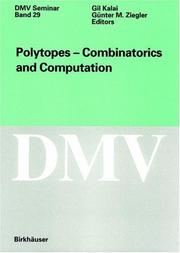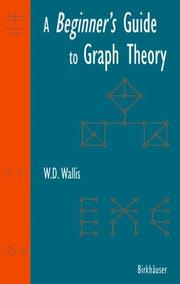| Listing 1 - 2 of 2 |
Sort by
|

ISBN: 3764363517 0817663517 Year: 2000 Volume: Bd. 29 Publisher: Basel Birkhäuser
Abstract | Keywords | Export | Availability | Bookmark
 Loading...
Loading...Choose an application
- Reference Manager
- EndNote
- RefWorks (Direct export to RefWorks)
Polytopes. --- Polytopes --- 519.1 --- 681.3*G21 --- 519.1 Combinatorics. Graph theory --- Combinatorics. Graph theory --- 681.3*G21 Combinatorics: combinatorial algorithms; counting problems; generating functions; permutations and combinations; recurrences and difference equations --- Combinatorics: combinatorial algorithms; counting problems; generating functions; permutations and combinations; recurrences and difference equations --- Hyperspace --- Topology

ISBN: 0817641769 1475731361 1475731345 9780817641764 Year: 2000 Publisher: Boston Birkhauser
Abstract | Keywords | Export | Availability | Bookmark
 Loading...
Loading...Choose an application
- Reference Manager
- EndNote
- RefWorks (Direct export to RefWorks)
Because of its wide applicability, graph theory is one of the fast-growing areas of modern mathematics. Graphs arise as mathematical models in areas as diverse as management science, chemistry, resource planning, and computing. Moreover, the theory of graphs provides a spectrum of methods of proof and is a good train ing ground for pure mathematics. Thus, many colleges and universities provide a first course in graph theory that is intended primarily for mathematics majors but accessible to other students at the senior Ievel. This text is intended for such a course. I have presented this course many times. Over the years classes have included mainly mathematics and computer science majors, but there have been several engineers and occasional psychologists as weil. Often undergraduate and graduate students are in the same dass. Many instructors will no doubt find themselves with similar mixed groups. lt is to be expected that anyone enrolling in a senior Ievel mathematics course will be comfortable with mathematical ideas and notation. In particular, I assume the reader is familiar with the basic concepts of set theory, has seen mathematical induction, and has a passing acquaintance with matrices and algebra. However, one cannot assume that the students in a first graph theory course will have a good knowledge of any specific advanced area. My reaction to this is to avoid too many specific prerequisites. The main requirement, namely a little mathematical maturity, may have been acquired in a variety of ways.
Graph theory --- Graph theory. --- 519.1 --- 681.3*G22 --- Combinatorics. Graph theory --- Graph theory: graph algorithms; network problems; path and tree problems; trees--See also {681.3*F22} --- 681.3*G22 Graph theory: graph algorithms; network problems; path and tree problems; trees--See also {681.3*F22} --- 519.1 Combinatorics. Graph theory --- Graphs, Theory of --- Theory of graphs --- Combinatorial analysis --- Topology --- Extremal problems --- Discrete mathematics. --- Combinatorics. --- Discrete Mathematics. --- Combinatorics --- Algebra --- Mathematical analysis --- Discrete mathematical structures --- Mathematical structures, Discrete --- Structures, Discrete mathematical --- Numerical analysis
| Listing 1 - 2 of 2 |
Sort by
|

 Search
Search Feedback
Feedback About UniCat
About UniCat  Help
Help News
News